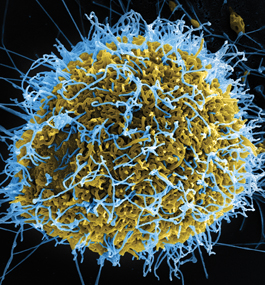Ebola as a Wake-Up Call

NIAID
Containment — the conventional response — isn’t the only answer. Prevention could stop the spread of Ebola, says epidemiologist Jonathan Epstein ’96, an expert on zoonotic viruses, which spill over from animal populations to humans. Ebola is a zoonotic disease. So are SARS, Nipah and H1N1.
“Ebola has shown it’s not just a disease that causes outbreaks in remote parts of Africa and fizzles out,” says Epstein, associate vice president of conservation medicine at EcoHealth Alliance, a science-based health and conservation organization. “It has the potential to get out of control and spread internationally. By understanding exactly how the disease spills over from animals to humans, we can get ahead of the game and prevent future outbreaks.”
The first step toward Ebola prevention, Epstein says, is identifying the animals most likely to carry the virus. Bats, a traditional food source for some West Africans, are the suspected culprit in the current outbreak. But occasionally the Ebola virus spills over from the carcasses of other animals infected by bats. That’s what happened in Central Africa, where infected great apes and antelopes were consumed by humans.
Education is the next step, says Epstein (who was profiled in “The Virus Hunter,” in the Spring 2013 issue). Misinformation, lack of information, fear and cultural practices contribute to Ebola’s spread. So do large societal shifts: the displacement of wildlife habitats by human communities, large-scale livestock farming, urbanization, climate change, global travel.
“If we can come up with realistic alternatives that work with the local populations, and change the way we encroach upon and interact with wildlife and ecosystems, we’ll be able to protect ourselves from the diseases we know about,” Epstein says. “Not to mention those we have yet to discover.”
— L.B.
